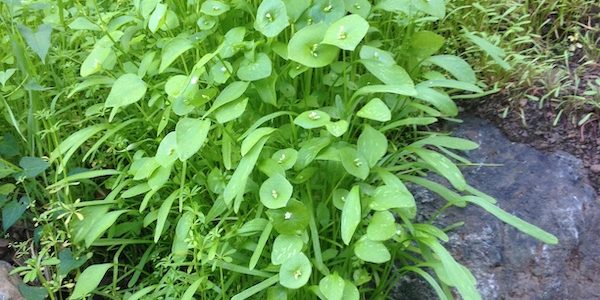
Indian lettuce (Claytonia perfoliata) is a wide spread annual common to coastal and mountainous regions of western North America. Typically seen cloaking the forest floor in cool moist places after the rains begin, it then dries up as the rains depart. During late summer and fall you will see no sign of the plant. Indian lettuce is a prolific seeder and will reappear in ideal spots year after year. In sunnier locations the leaves turn bright red as excess sugars are converted to protective pigmentation. Its seeds can lay dormant in the soil for long periods of time. After a fire, profuse dormant seed banks germinate in an explosion of growth producing a succulent protective cover for newly exposed soil. Indian lettuce can be eaten raw as the name implies. It can also be cooked like spinach.
Early in the green season when plant life seems to suddenly shift into gear I often find myself studying the new flush of growth to figure out what I am seeing. When getting to know young Indian lettuce it is easy to be tricked. We all think of the rounded (fused) leaves holding clusters of tiny white flowers. But if you look in January/February you will see that the first (seed) leaves are strap shaped. Next up are sets of true leaves with an appealing spatula shape. And then finally when the mature plant sends up flowering stems the leaves begin to show the more easily recognizable rounded shape. The mature plant can range from a few inches to over a foot in height.
This time of year newly green cloaked hills seem to invite one to wander along gawking at it all. The wander ways of our urban landscape hold a host of passages into the wider world. Walking near the UC Berkeley Campus one finds several points of access to the hills and open spaces. If the hills are calling, head up Dwight Way to Derby Canyon. From there you can take a short neighborhood hike or connect through the East West Trail to the Skyline Trail and on down Siesta Valley all the way to Orinda (check the Claremont Canyon Conservancy’s map if you want help planning a route). Taking a self propelled trip up behind Clark Kerr Campus will give you a chance to see spring unfolding AND provide a chance to appreciate the improvements wrought by Take To The Hills (a volunteer group) in converting this long neglected trail from a scatter of erosion gullies to a pleasant if somewhat aerobic way to stroll into the world beyond the pavement.
Derby Canyon trail begins with a climb up under a canopy of non-native blue gum Eucalyptus which seems discouraging at first but then if you look into the understory to the south of the trail you will see lush patches of Indian lettuce. On up switchbacks and sets of steps the hillsides of Derby Canyon are revealed to be primarily grassland dominated by non-native annual grasses with patches of coastal scrub transitioning to mixed evergreen woodland vegetation closer to the creek. Take To The Hills has a long term plan to restore floristic diversity to Derby Canyon. Using techniques to prevent non-native seed set by clearing undesirables and burning off weed seedlings with vinegar spray, remarkable progress has been made. Local natives are being planted along the trails where they can be enjoyed by trail users while also adding desirable native seed to the mix. If you’d like to help out, regular planting and weeding days are Tuesday and Saturday mornings from 9 to noon. Contact Jim Rosenau at (510) 845-0106 or go to https://taketothehills.net/volunteer.